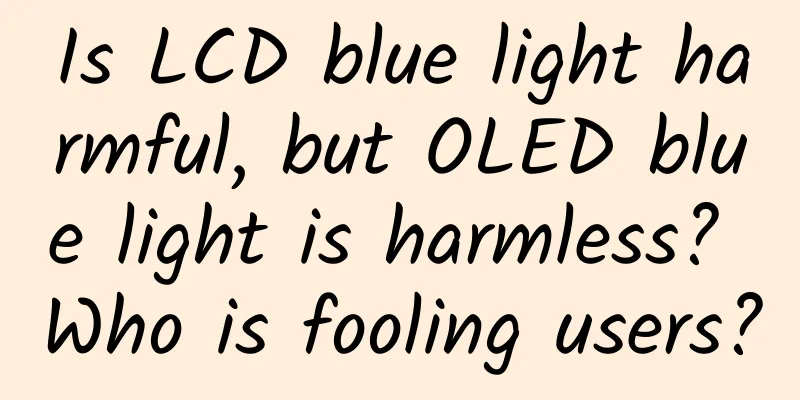Is LCD blue light harmful, but OLED blue light is harmless? Who is fooling users?

|
In the past six months, in the color TV market, a piece of news about the blue light from LCD TVs being harmful to the eyes has been spreading and fermenting among the shopping guides of some color TV manufacturers, causing concern among many users. A media reporter found that those who spread the message that blue light from LED LCD TVs is harmful are mainly some sales guides selling OLED TVs. They just want to tell consumers that blue light also exists, but LED LCDs are inorganic materials, while OLEDs are organic materials. Because they are not worried about blue light causing harm to human eyes, they should choose OLED TVs for the health of their families, especially children. However, Zhijiadian found in its investigation that whether it is inorganic LED LCD TV, organic OLED TV, or even quantum dot TV, they all involve blue light, and the wavelength of blue light in the three display technologies is basically the same. In other words, if LED blue light is harmful to the human eye, then OLED and quantum dots may also be harmful. So why is blue light harmful on LCD TVs, but healthy for the human eye on OLED TVs? What secrets are hidden behind this? Recently, Dr. Luo Zhongsheng, General Manager of Greater China and Director of Application Engineering of Nanosys, a company that has been researching display technology for a long time, disclosed to the media a research finding: Red, green and blue constitute the three primary colors of TV display. Whether it is LED liquid crystal, quantum dot TV or OLED TV, the product life span varies greatly due to the different materials used. The key factor affecting the life span is blue light. Luo Zhongsheng found that due to the high energy of blue light photons, it is easy to cause material decay. OLED is a high-molecular organic material, and the short life of blue light has become an unavoidable shortcoming. In contrast, the blue light sources of LED LCD TVs and quantum dot TVs are inorganic materials, which essentially have a longer lifespan than OLED. Data shows that it is at least 5 times longer. Consumers who often travel to the United States on business can go to any physical store of a US telecom company. The OLED phones they display have the problem of image retention because they are always turned on during the day and often display the same picture. This is because the blue light problem of OLED technology has not been solved well, and the life span is very short. This is only OLED on small-screen mobile phones. If OLED is displayed on a large-screen TV, the problem will be more prominent. An insider of a color TV company revealed, "That year, LGD launched the OLED display panel and defined it as the next-generation display technology. The company's relevant leaders also attached great importance to it and purchased more than 100 OLED display panels and produced corresponding engineering machines. Whether it was placed in the laboratory or in some product showrooms, OLED TVs showed severe color attenuation in just one year. Ultimately, this caused the company to suspend the OLED project." Although OLED screens are currently used in mobile phones, they also have a series of problems such as color afterimages, but since mobile phones are fast-moving consumer goods, they are replaced on average every year or so, so consumers are not sensitive to the color afterimages of OLED phones. However, it is different for TVs, which are generally replaced every seven or eight years. At the same time, because the screen is large, consumers have higher expectations for the color of this type of product. Luo Zhongsheng emphasized, "OLED has afterimages or screen burn-in because the blue light lifespan is not enough. If you are a professional, you can clearly see the change in the white screen of the OLED TV due to the attenuation of the blue itself. The professional term is white point drift. If an ordinary consumer buys an OLED TV, he will find that the white screen will become more and more yellowish when comparing it every month. That's because its blue light is getting weaker and weaker." Last year, Samsung chose to abandon the application of OLED in TVs and instead chose quantum dot TVs as its future development direction. It was also based on the fact that quantum dot TVs do not have the problem of short lifespan of blue light, so they made a 10-year burn-in guarantee for quantum dot TVs. Similarly, the issue that consumers are most concerned about is that blue light is harmful to the eyes on LED LCD TVs, but not on OLED TVs. In fact, as early as many years ago when LED LCD TVs were launched, it was proven that the rumor that blue light LED TVs are harmful is a rumor. Blue light is light with a wavelength between 400 and 500 nanometers. Studies have shown that the shorter the wavelength, the higher the energy and the stronger the penetration. As early as 2014, an experiment conducted by the Vision Health Laboratory of the China National Institute of Standardization showed that only when the peak spectrum of blue light is within the range of 460-500 nanometers, the illumination exceeds 1500lx (unit of illumination), and it is directly exposed for more than 3 hours, will cell vitality decrease significantly. Since the illumination of the current household lighting environment generally does not exceed 600lx, and LED LCD TVs all use backlight or sidelight, the blue light wavelength is mostly around 450 nanometers to achieve the best color gamut. Therefore, LED display screens will not cause the harm of blue light, and it is even less likely to cause damage to the retina. At the same time, due to material life and efficiency reasons, OLED generally uses 460-480 nanometers of blue light, so the relative blue color purity is not as good as LED, which will reduce the color gamut, especially affecting the performance in blue. "From the perspective of technological innovation, OLED has made significant technological progress compared to ten years ago, but there is still a gap from the ultimate needs of users. So we can only say that OLED is currently in the early stages of being able to be used commercially, but there are still many problems if it is to be widely popularized in the TV market," Luo Zhongsheng is worried. When technical problems such as afterimage and screen burn-in have not been fundamentally solved, and the lifespan of blue light is still declining year by year, there is a great risk in rashly promoting the large-scale popularization of OLED TVs. The truth is that both LED LCD and OLED TV use similar blue light wavelengths and are unlikely to cause harm to human eyes. On the contrary, the use of blue light in OLED is not only not healthier, but also because of the organic materials, the short life of blue light will eventually lead to frequent problems such as afterimages and even screen burn-in on OLED TVs over time, affecting the actual user experience. Because a series of technical defects of OLED TVs have not been solved, sales of its products have stagnated in the global and Chinese markets over the past three or four years. In the Chinese market, according to CMM data, the total sales of OLED in the Chinese color TV market in 2016 was 33,000 units, with LG and Skyworth selling 16,000 and 11,000 units respectively. This is far from Skyworth's goal of selling 200,000 OLED TVs at the beginning of last year. In the global market, Qunzhi Consulting statistics show that the global sales of OLED TVs in 2016 were 850,000 units, which is significantly different from the total global shipments of LCD TVs of 219 million units in the same period. As a winner of Toutiao's Qingyun Plan and Baijiahao's Bai+ Plan, the 2019 Baidu Digital Author of the Year, the Baijiahao's Most Popular Author in the Technology Field, the 2019 Sogou Technology and Culture Author, and the 2021 Baijiahao Quarterly Influential Creator, he has won many awards, including the 2013 Sohu Best Industry Media Person, the 2015 China New Media Entrepreneurship Competition Beijing Third Place, the 2015 Guangmang Experience Award, the 2015 China New Media Entrepreneurship Competition Finals Third Place, and the 2018 Baidu Dynamic Annual Powerful Celebrity. |
>>: Russia's flying electric car starts accepting pre-orders, priced from 500,000 rubles
Recommend
Are wristbands a viable solution to the problem of video game peripherals?
Since the beginning of the year, motion-sensing b...
Is it inconvenient to take a taxi during the Spring Festival? Don't miss these three electric vehicles that can be purchased with only the year-end bonus
It's the Spring Festival holiday again. Altho...
Xiaomi Clearance Festival data analysis: more youthful than rich
The Mi Fan Festival is over, and Lei Jun quickly ...
Ski jumping: Why don’t you get hurt when you land after flying off a 100-meter-high cliff?
Have you ever watched ski jumping? The athletes s...
Is it the millet's fault? The once popular staple food is now hard to find
As a country of foodies, I guess everyone knows a...
How long does it take to make an e-commerce mini program? How long does it take to develop a small program?
E-commerce is something that many people are awar...
"91 Ten Articles" - A daily must-read briefing for the new energy vehicle industry (210210)
1. The California Department of Transportation (D...
The monetization rules of private domain traffic
Private domain traffic belongs to a single indivi...
User Operations: 5 Case Studies to Teach You How to Insight into User Needs
The most difficult thing is to write an introduct...
Analysis of competing products of Jelly Social APP!
Some time ago, a social APP called Jelly suddenly...
Sunflower releases Windows 2.9 control terminal, supports screen recording, screenshot, and chat
On September 26, Sunflower, a well-known domestic...
Looking forward to 6G, what can it bring to our lives?
Chen Zhigang Currently, 5G has been commercialize...
Sunbathing my back for 10 days made me lose 4 catties. Can sunbathing your back during the dog days really help you lose weight? The truth is →
"Sunbathing your back more during the dog da...









